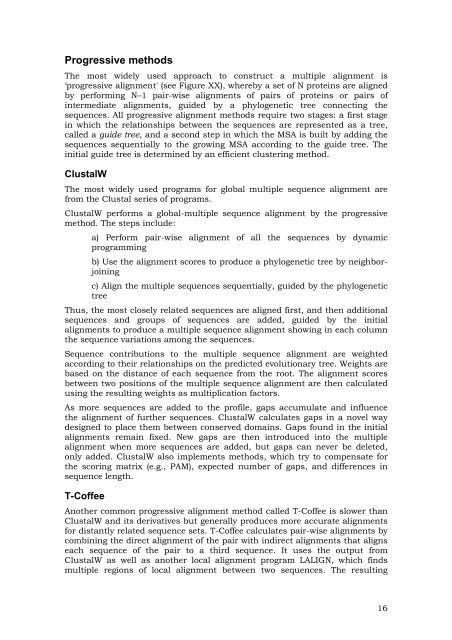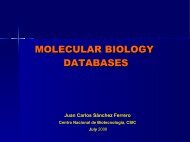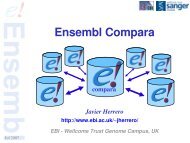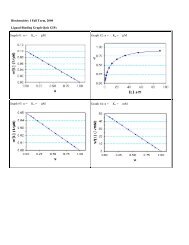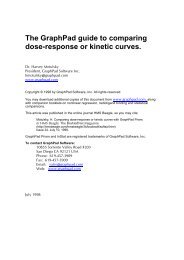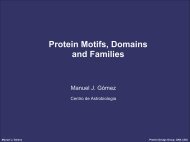Practical Course on Multiple Sequence Alignment - CNB - Protein ...
Practical Course on Multiple Sequence Alignment - CNB - Protein ...
Practical Course on Multiple Sequence Alignment - CNB - Protein ...
You also want an ePaper? Increase the reach of your titles
YUMPU automatically turns print PDFs into web optimized ePapers that Google loves.
Progressive methods<br />
The most widely used approach to c<strong>on</strong>struct a multiple alignment is<br />
‘progressive alignment' (see Figure XX), whereby a set of N proteins are aligned<br />
by performing N–1 pair-wise alignments of pairs of proteins or pairs of<br />
intermediate alignments, guided by a phylogenetic tree c<strong>on</strong>necting the<br />
sequences. All progressive alignment methods require two stages: a first stage<br />
in which the relati<strong>on</strong>ships between the sequences are represented as a tree,<br />
called a guide tree, and a sec<strong>on</strong>d step in which the MSA is built by adding the<br />
sequences sequentially to the growing MSA according to the guide tree. The<br />
initial guide tree is determined by an efficient clustering method.<br />
ClustalW<br />
The most widely used programs for global multiple sequence alignment are<br />
from the Clustal series of programs.<br />
ClustalW performs a global-multiple sequence alignment by the progressive<br />
method. The steps include:<br />
a) Perform pair-wise alignment of all the sequences by dynamic<br />
programming<br />
b) Use the alignment scores to produce a phylogenetic tree by neighborjoining<br />
c) Align the multiple sequences sequentially, guided by the phylogenetic<br />
tree<br />
Thus, the most closely related sequences are aligned first, and then additi<strong>on</strong>al<br />
sequences and groups of sequences are added, guided by the initial<br />
alignments to produce a multiple sequence alignment showing in each column<br />
the sequence variati<strong>on</strong>s am<strong>on</strong>g the sequences.<br />
<strong>Sequence</strong> c<strong>on</strong>tributi<strong>on</strong>s to the multiple sequence alignment are weighted<br />
according to their relati<strong>on</strong>ships <strong>on</strong> the predicted evoluti<strong>on</strong>ary tree. Weights are<br />
based <strong>on</strong> the distance of each sequence from the root. The alignment scores<br />
between two positi<strong>on</strong>s of the multiple sequence alignment are then calculated<br />
using the resulting weights as multiplicati<strong>on</strong> factors.<br />
As more sequences are added to the profile, gaps accumulate and influence<br />
the alignment of further sequences. ClustalW calculates gaps in a novel way<br />
designed to place them between c<strong>on</strong>served domains. Gaps found in the initial<br />
alignments remain fixed. New gaps are then introduced into the multiple<br />
alignment when more sequences are added, but gaps can never be deleted,<br />
<strong>on</strong>ly added. ClustalW also implements methods, which try to compensate for<br />
the scoring matrix (e.g., PAM), expected number of gaps, and differences in<br />
sequence length.<br />
T-Coffee<br />
Another comm<strong>on</strong> progressive alignment method called T-Coffee is slower than<br />
ClustalW and its derivatives but generally produces more accurate alignments<br />
for distantly related sequence sets. T-Coffee calculates pair-wise alignments by<br />
combining the direct alignment of the pair with indirect alignments that aligns<br />
each sequence of the pair to a third sequence. It uses the output from<br />
ClustalW as well as another local alignment program LALIGN, which finds<br />
multiple regi<strong>on</strong>s of local alignment between two sequences. The resulting<br />
16


